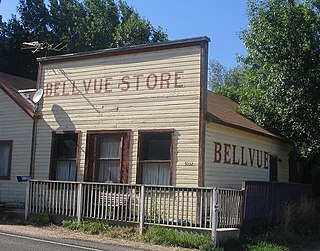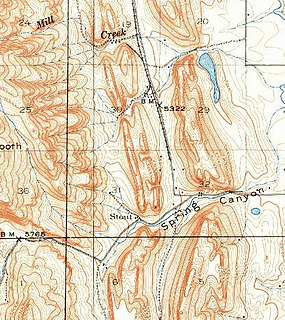
Laporte is a census-designated place (CDP) in Larimer County, Colorado, United States. The population was 2,691 at the 2000 census. The Laporte Post Office has the ZIP Code 80535.

Benjamin Harrison Eaton was an American politician, entrepreneur and agriculturalist in the late 19th and early 20th century. Eaton was a founding officer of the Greeley Colony and was instrumental in the establishment of modern irrigation farming to Northern Colorado. A member of the Republican Party, he served as the fourth Governor of Colorado, from January 1885 to January 1887, with the nickname of the "farmer governor". He was one of the largest land owners in Weld and Larimer counties, at one time owning over ninety 160 acre (0.6 km²) parcels, all watered from canals and reservoirs of his own construction. His projects were influential in helping turn the South Platte River valley into an important agricultural region in the state's economy. The town of Eaton, Colorado in western Weld County is named for him.
The Colorado Piedmont is an area along the base of the foothills of the Front Range in north central Colorado in the United States. The region consists of a broad hilly valley, just under 5000 ft in elevation, stretching north and northeast from Denver in the valley of the South Platte River, as well as along the Arkansas River valley southward from Colorado Springs. The region includes much of the populated and cultivated area of Colorado. The name Colorado Piedmont also refers to the physiographic section of the Great Plains province.

Horsetooth Reservoir is a large reservoir in southern Larimer County, Colorado, just west of the city of Fort Collins, Colorado. The reservoir sits in the foothills above the town on the western side of the Dakota Hogback, which contains the reservoir along its eastern side. The reservoir runs north-south for approximately 6.5 miles (10 km) and is approximately one-half mile (1 km) wide. It was constructed in 1949 by the Bureau of Reclamation as part of its federal Colorado-Big Thompson Project or "C-BT". Water distribution is currently managed by Reclamation and operated by the Northern Colorado Water Conservancy District. Horsetooth and Carter Lake serve as the two principal reservoirs for water diverted eastward under the continental divide via the C-BT.
The Greeley, Salt Lake and Pacific Railway was a railroad that operated in northern Colorado in the United States during the 1880s. Founded with heavy backing with the Union Pacific Railroad, it was controlled by the Union Pacific from its inception, but was incorporated into the new Colorado and Southern Railway in 1898, becoming part of the Chicago, Burlington and Quincy Railroad in 1908.
The Fort Collins Agricultural Colony was a 19th-century enterprise in Larimer County, Colorado to promote new agricultural and commercial settlement in and around the town of Fort Collins. Founded in the autumn of 1872 as an outgrowth of the Union Colony in nearby Greeley, the colony was instrumental in the early growth of Fort Collins, as well as in making it an agricultural center in the Colorado Territory at a time when the region was still known primarily for its mineral resources.
The Union Colony of Colorado was a 19th-century private enterprise formed to promote agricultural settlements in the South Platte River valley in the Colorado Territory. Organization of the colony began in October 1869 by Nathan Meeker in order to establish a religiously oriented utopian community of "high moral standards". The colony was founded in March 1870 at the site of present-day Greeley, Colorado. Union Colony was financially backed and promoted by New York Tribune editor, Horace Greeley, a prominent advocate of the settlement of the American West. The homesteaded colony greatly advanced irrigation usage in present-day northern Colorado, demonstrating the viability of cultivation at a time when agriculture was emerging as a rival to mining as the principal basis for the territorial economy.

Antoine Janis was a 19th-century French-American fur trader and an early white homesteader in Larimer County, Colorado, in the United States. The first recorded permanent white settler in northern Colorado, he founded the town of Laporte in 1858.
Camp Collins was a 19th-century outpost of the United States Army in the Colorado Territory. The fort was commissioned in the summer of 1862 to protect the Overland Trail from attacks by Native Americans in a conflict that later became known as the Colorado War. Located along the Cache la Poudre River in Larimer County, it was relocated from its initial location near Laporte after a devastating flood. Its second location downstream on the Poudre was used until 1866 and became the nucleus around which the City of Fort Collins was founded.

Kinikinik is a small unincorporated community in western Larimer County, Colorado in the United States. It is located along State Highway 14 in the upper Poudre Canyon west of Fort Collins on the east side of Cameron Pass. The community consists of a general store and neighboring summer mountain resorts and vacation homes. The activities include fishing in the Cache la Poudre River and hiking in the nearby mountains in the Roosevelt National Forest. The community was named for the kinnikinick plant by early settlers.
The North Fork Cache la Poudre River is a tributary of the Cache la Poudre River, approximately 59.2 miles (95.3 km) long, in north central Colorado in the United States. It drains a mountainous area of north central Larimer County northwest of Fort Collins on the western side of the Laramie Foothills.

The High Park fire was a wildfire in the mountains west of Fort Collins in Larimer County, Colorado, United States. It was caused by a lightning strike and was first detected on the morning of June 9, 2012. It was declared 100 percent contained on June 30, 2012, and all associated evacuation orders were lifted.
Poudre City is a ghost town located in the foothills of the Rocky Mountains in northwestern Larimer County, Colorado, United States. The town was founded in 1890 around a gold reducing stamp mill. The town was destroyed on June 10, 1891 when the Chambers Lake dam burst and swept down the Poudre Canyon. All that remains of the town today is the chimney from the stamp mill.

Goat Hill—also called Bellvue Dome—is a dome in Larimer County, Colorado near Bellvue.



















